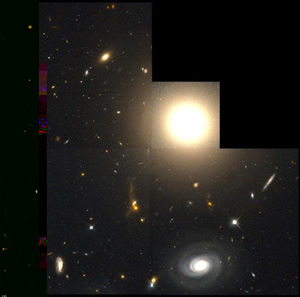The Coma Cluster of Galaxies
Click on image for full size
Courtesy of NASA.
Elliptical Galaxies
Elliptical galaxies come in a range of shapes and sizes. They can be
circular or egg-shaped. They can be very large and bright (giants!)
or rather small and dim (dwarfs!). Elliptical galaxies are old. They
formed all their stars a long time ago, and no new stars are being
born.
If you have the chance to see one through a small telescope, it will
probably look just like a fuzzy smudge to you, a piece of lint. But
it is really formed of many billions of stars orbitting the center of
the galaxy, just as the Earth orbits the Sun. All the light of the
galaxy comes from the stars.
Galaxies like to live together in groups called clusters. In
clusters, there are hundreds of galaxies. Most of the galaxies in
clusters are elliptical galaxies.
You might also be interested in:

When we look up at the night sky, we notice that there are many stars in our sky. Stars must like to live together in star cities - galaxies. Our city of stars is called the Milky Way, and it is home to
...more
Satellites in the 1960's looked for a type of light called Gamma Rays. They found bursts of Gamma Rays coming from outer space! They can't hurt you. They are stopped by the Earth's atmosphere. We have
...more
Neutron Stars form when really big stars die. When such a star runs out of fuel its center begins to collapse under gravity. When the center collapses the entire star collapses. The surface of the star
...more
Spiral galaxies may remind you of a pinwheel that blows in the breeze. Like a pinwheel, a spiral galaxy is rotating, and it has spiral arms. Through a telescope or binoculars,a spiral galaxy may look
...more
When stars like our own sun die they will become White Dwarfs. As a star like our sun is running out of fuel in its center it grows into a red giant. This will happen to our sun in 5 Billion years. The
...more
What's in a Name: Arabic for "head of the demon" Claim to Fame: Represents Medusa's eye in Perseus. A special variable star that "winks" every 3 days. Type of Star: Blue-white Main Sequence Star, and
...more
What's in a Name: Nicknamed the "Pup" because it is the companion to Sirius, "the Dog Star" Claim to Fame: Highly compressed white dwarf remnant. Density about 50,000 times that of water. It has approximately
...more















